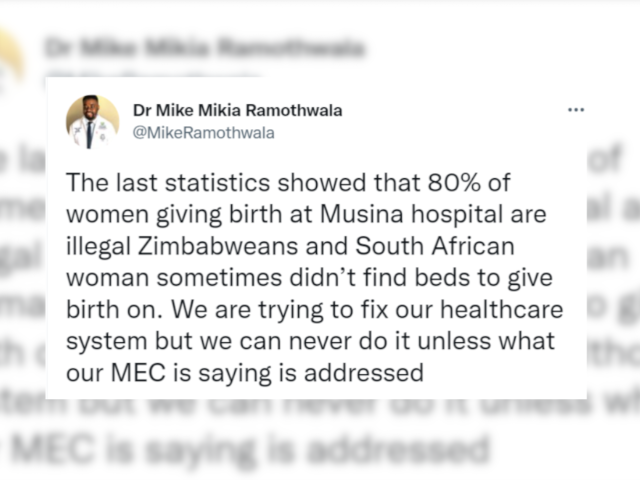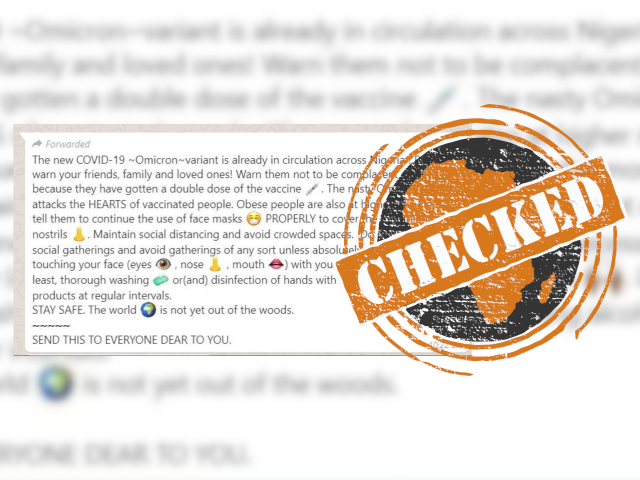Showing two children talking on the phone, a meme shared on Facebook in Nigeria warns about the effect of cellphone radiation on the brain.
“Use only your LEFT EAR when using mobile phones, and avoid using the RIGHT EAR, as that makes our brain more prone to mobile radiation,” says the meme, posted in 2017.
Does putting your phone to your right ear make your brain more vulnerable to the phone’s radiation?

There is no credible information that mentions “any correlation between increased health risks and the habitual use of the right ear for mobile calls”, says Hoax-Slayer.
The site updated its research in 2013, saying that even though a similar message had appeared, there was “still nary a shred of evidence to back the claims in either version of the message”.
Hoax-Slayer warns that the message is likely to be a hoax because “like other such warnings, the message does not include any external references to support its claims”.
Africa Check spoke to Mr Leon du Toit, the Deputy Director of Non-Ionizing Radiation & Medical Devices of the Directorate Radiation Control at the National Department of Health.
He says that cell phones make use of what is called “non-ionising radiation” to operate. Non-ionising radiation refers to, says du Toit, “radiowaves or microwaves used for telecommunications (radio, TV, cell phones), heating (microwave ovens and industrial applications) and medical purposes (electrosurgery).”
This is in comparison to what is called “ionising radiation”. “Short modalities such as X-rays involve the use of ionising radiation”, says du Toit.
The more a person is exposed to ionising radiation, says du Toit, “the bigger chance that one could develop some kind of cancer over time - because very high energy of ionising radiation is able to directly damage a person’s DNA, and this damage over time could give rise to some form of cancer.”
However, he says, non-ionising radiation (the radiation caused by cellphones) “does not possess enough energy by a long shot to damage the DNA of any person, and there exists no scientific evidence that exposure to no-ionising radiation could cause cancer.”
Du Toit continues to state that there have been results from surveys around the world that show “the exposure of the general public to both cellular base stations and handsets are on average way below the relevant international commission on non-ionising radiation protection (ICNIRP) limit.”
ICNIRP is an independent organization that provides scientific advice and guidance on the health and environmental effects of non-ionizing radiation (NIR) to protect people and the environment from detrimental NIR exposure.
Therefore, there would be “no logical reason to suspect that this kind of exposure would in any way be bad for human health,” says du Toit.
Leon du Toit also provided Africa Check with an open letter explaining the viewpoint of the department of health in regards to the health effects of cellular communications equipment.
The letter quotes the findings of a World Health Organisation (WHO) fact sheet: “considering the very low exposure levels and research results collected to date, there is no convincing scientific evidence that weak radiofrequence signals from base stations and wireless networks cause adverse health effects.”
The letter mentions another WHO fact sheet was reviewed in 2014 and found that “a large number of studies have been performed over the last two decades to assess whether mobile phones pose a potential health risk.”
“No adverse health effects have been established as being caused by mobile phone use,” says the fact sheet.
At present (2019) there is “no confirmed scientific evidence” that shows any health risks associated with the very low levels of exposure from cellular base stations.
“Generally-speaking unless a person would climb to the top of a mast and position him/herself not more than a few meters away right in front of the active antenna, such a person would have no real possibility of being exposed to even anywhere near the aforementioned ICNIRP guideline limits.” - Taryn Willows
“Use only your LEFT EAR when using mobile phones, and avoid using the RIGHT EAR, as that makes our brain more prone to mobile radiation,” says the meme, posted in 2017.
Does putting your phone to your right ear make your brain more vulnerable to the phone’s radiation?

No correlation between the use of the right ear and increased health risks
There is no credible information that mentions “any correlation between increased health risks and the habitual use of the right ear for mobile calls”, says Hoax-Slayer.
The site updated its research in 2013, saying that even though a similar message had appeared, there was “still nary a shred of evidence to back the claims in either version of the message”.
Hoax-Slayer warns that the message is likely to be a hoax because “like other such warnings, the message does not include any external references to support its claims”.
Ionising & non-ionising radiation
Africa Check spoke to Mr Leon du Toit, the Deputy Director of Non-Ionizing Radiation & Medical Devices of the Directorate Radiation Control at the National Department of Health.
He says that cell phones make use of what is called “non-ionising radiation” to operate. Non-ionising radiation refers to, says du Toit, “radiowaves or microwaves used for telecommunications (radio, TV, cell phones), heating (microwave ovens and industrial applications) and medical purposes (electrosurgery).”
This is in comparison to what is called “ionising radiation”. “Short modalities such as X-rays involve the use of ionising radiation”, says du Toit.
The more a person is exposed to ionising radiation, says du Toit, “the bigger chance that one could develop some kind of cancer over time - because very high energy of ionising radiation is able to directly damage a person’s DNA, and this damage over time could give rise to some form of cancer.”
However, he says, non-ionising radiation (the radiation caused by cellphones) “does not possess enough energy by a long shot to damage the DNA of any person, and there exists no scientific evidence that exposure to no-ionising radiation could cause cancer.”
Du Toit continues to state that there have been results from surveys around the world that show “the exposure of the general public to both cellular base stations and handsets are on average way below the relevant international commission on non-ionising radiation protection (ICNIRP) limit.”
ICNIRP is an independent organization that provides scientific advice and guidance on the health and environmental effects of non-ionizing radiation (NIR) to protect people and the environment from detrimental NIR exposure.
Therefore, there would be “no logical reason to suspect that this kind of exposure would in any way be bad for human health,” says du Toit.
Open letter from the department of health
Leon du Toit also provided Africa Check with an open letter explaining the viewpoint of the department of health in regards to the health effects of cellular communications equipment.
The letter quotes the findings of a World Health Organisation (WHO) fact sheet: “considering the very low exposure levels and research results collected to date, there is no convincing scientific evidence that weak radiofrequence signals from base stations and wireless networks cause adverse health effects.”
The letter mentions another WHO fact sheet was reviewed in 2014 and found that “a large number of studies have been performed over the last two decades to assess whether mobile phones pose a potential health risk.”
“No adverse health effects have been established as being caused by mobile phone use,” says the fact sheet.
At present (2019) there is “no confirmed scientific evidence” that shows any health risks associated with the very low levels of exposure from cellular base stations.
“Generally-speaking unless a person would climb to the top of a mast and position him/herself not more than a few meters away right in front of the active antenna, such a person would have no real possibility of being exposed to even anywhere near the aforementioned ICNIRP guideline limits.” - Taryn Willows
Republish our content for free
For publishers: what to do if your post is rated false
A fact-checker has rated your Facebook or Instagram post as “false”, “altered”, “partly false” or “missing context”. This could have serious consequences. What do you do?
Click on our guide for the steps you should follow.
Publishers guideAfrica Check teams up with Facebook
Africa Check is a partner in Meta's third-party fact-checking programme to help stop the spread of false information on social media.
The content we rate as “false” will be downgraded on Facebook and Instagram. This means fewer people will see it.
You can also help identify false information on Facebook. This guide explains how.





Add new comment